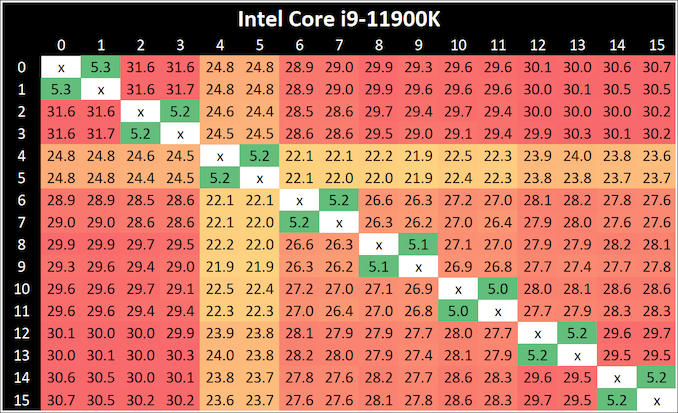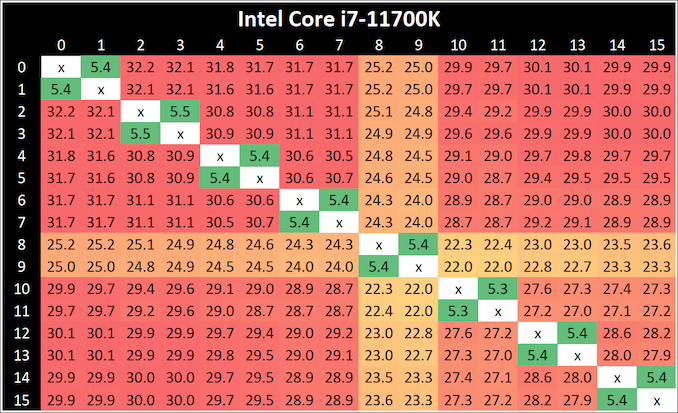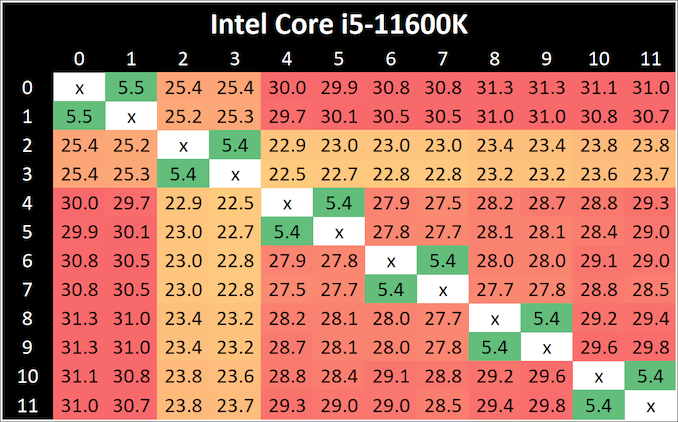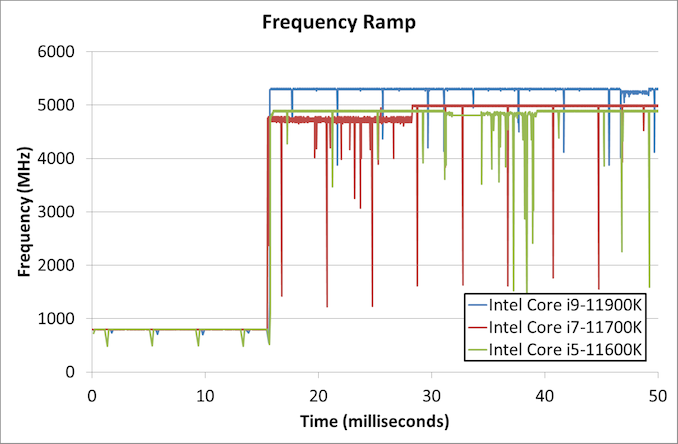Intel Rocket Lake (14nm) Review: Core i9-11900K, Core i7-11700K, and Core i5-11600K
by Dr. Ian Cutress on March 30, 2021 10:03 AM EST- Posted in
- CPUs
- Intel
- LGA1200
- 11th Gen
- Rocket Lake
- Z590
- B560
- Core i9-11900K
CPU Tests: Microbenchmarks
Core-to-Core Latency
As the core count of modern CPUs is growing, we are reaching a time when the time to access each core from a different core is no longer a constant. Even before the advent of heterogeneous SoC designs, processors built on large rings or meshes can have different latencies to access the nearest core compared to the furthest core. This rings true especially in multi-socket server environments.
But modern CPUs, even desktop and consumer CPUs, can have variable access latency to get to another core. For example, in the first generation Threadripper CPUs, we had four chips on the package, each with 8 threads, and each with a different core-to-core latency depending on if it was on-die or off-die. This gets more complex with products like Lakefield, which has two different communication buses depending on which core is talking to which.
If you are a regular reader of AnandTech’s CPU reviews, you will recognize our Core-to-Core latency test. It’s a great way to show exactly how groups of cores are laid out on the silicon. This is a custom in-house test built by Andrei, and we know there are competing tests out there, but we feel ours is the most accurate to how quick an access between two cores can happen.
All three CPUs exhibit the same behaviour - one core seems to be given high priority, while the rest are not.
Frequency Ramping
Both AMD and Intel over the past few years have introduced features to their processors that speed up the time from when a CPU moves from idle into a high powered state. The effect of this means that users can get peak performance quicker, but the biggest knock-on effect for this is with battery life in mobile devices, especially if a system can turbo up quick and turbo down quick, ensuring that it stays in the lowest and most efficient power state for as long as possible.
Intel’s technology is called SpeedShift, although SpeedShift was not enabled until Skylake.
One of the issues though with this technology is that sometimes the adjustments in frequency can be so fast, software cannot detect them. If the frequency is changing on the order of microseconds, but your software is only probing frequency in milliseconds (or seconds), then quick changes will be missed. Not only that, as an observer probing the frequency, you could be affecting the actual turbo performance. When the CPU is changing frequency, it essentially has to pause all compute while it aligns the frequency rate of the whole core.
We wrote an extensive review analysis piece on this, called ‘Reaching for Turbo: Aligning Perception with AMD’s Frequency Metrics’, due to an issue where users were not observing the peak turbo speeds for AMD’s processors.
We got around the issue by making the frequency probing the workload causing the turbo. The software is able to detect frequency adjustments on a microsecond scale, so we can see how well a system can get to those boost frequencies. Our Frequency Ramp tool has already been in use in a number of reviews.
From an idle frequency of 800 MHz, It takes ~16 ms for Intel to boost to the top frequency for both the i9 and the i5. The i7 was most of the way there, but took an addition 10 ms or so.














279 Comments
View All Comments
Billy Tallis - Tuesday, March 30, 2021 - link
Ian needs three matched GPUs to keep multiple testbeds running in parallel, otherwise it would take far too long to run a reasonable number of CPUs through this kind of test suite. Sourcing three GPUs like that is a lot harder than getting an individual review sample.shabby - Wednesday, March 31, 2021 - link
Plenty of gpus on eBay 😂Oxford Guy - Wednesday, March 31, 2021 - link
There is no good explanation for not testing AMD with the same wind tunnel copper cooler as used on the Intel.And, both should be tested with a popular cheap cooler like the EVO. The budget has to include cooler cost. And, if AMD has parts that perform just as well with an EVO that is a difference in availability, not only in terms of parts people have lying around but also in terms of being able to easily buy one in a computer store.
Don't have time to do all the tests, ok. Choose the most computer-consuming game, the most power-consuming AVX-2 bench, whatever your standard AVX-512 is, and one non-AVX power-demanding real-world bench. That's four tests, which should be easily done.
Qasar - Wednesday, March 31, 2021 - link
" There is no good explanation for not testing AMD with the same wind tunnel copper cooler as used on the Intel. " yes there is, cant mount it to the board as it doesnt fit, cause there is no mounting hardware.Oxford Guy - Thursday, April 1, 2021 - link
Then pick a different cooler for an apples to apples comparison.That’s obvious.
Qasar - Thursday, April 1, 2021 - link
and if you dont happen to have one on hand, and dont have the time to go and get one ?even that should of been obvious to you.
Oxford Guy - Saturday, April 3, 2021 - link
What’s obvious is that this is an old professional organization. That means very basic things like apples-apples cooler tests are expected.Makste - Tuesday, April 6, 2021 - link
AgreedOxford Guy - Wednesday, March 31, 2021 - link
Those 2080 Tis are running for extremely high prices these days.Maybe they should switch to something people can get for an affordable price, like a $250 Radeon 7750 or GeForce 1030.
BushLin - Wednesday, March 31, 2021 - link
So... Create a GPU bottleneck in a CPU review? I can see it now: Every CPU scored the same in our gaming benchmarks... The $100 CPU looks fantastic value!